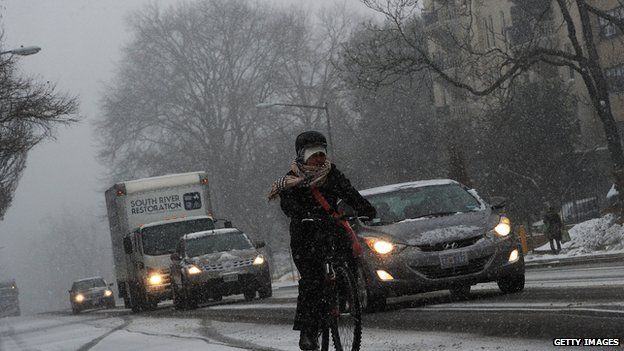Sneckdown: Using snow to design safer streets
- Published

Massive snowfalls like the one that hit the US east coast this week usually spell trouble for traffic. But critics of America's car-centric transport network are using the snow - and Twitter - to demonstrate how roads should be redesigned to make them safer for pedestrians.
Fast-falling snow can lead to unsafe driving conditions, massive pile-ups, delayed trains, cancelled flights and slippery sidewalks.
But advocates for safer streets say the snow can also help illustrate how conditions can be improved.
"The snow is almost like nature's tracing paper," says Clarence Eckerson Jr, the director of StreetFilms, which documents pedestrian- and cycle-friendly streets across the globe. He says that snow can be helpful in pointing out traffic patterns and changing street composition for the better.
"When you dump some snow on this giant grid of streets, now you can see, visually, how people can better use the streets," he says.
The best example of this is what Eckerson calls a snowy neckdown.
Neckdowns, protrusions of pavement that give pedestrians a safe place to stand as they wait to cross the street and make street crossing easier, have long been a tool for traffic planners, says Stefanie Seskin, deputy director of the National Complete Streets Coalition.
"It's a terrible name for a really great concept," says Seskin, who prefers the name "kerb extenders".
Streets should be designed for everyone who uses them, not just drivers, she says. Neckdowns are one way to help make roads more inclusive.
"You extend the pedestrian area into the intersection to make the crossing distance shorter and give a greater level of visibility to people who are driving."
The wider kerbs allow pedestrians to spend less time crossing the street, since the driving lanes are narrower. The neckdowns also force cars to make slower, safer turns into intersections. By discouraging drivers from parking close to a corner, they give motorists a better view of the intersection as they head into a turn.
Though popular with those who favour more pedestrian-friendly streets, neckdown critics say they take needed street space away from cars and slow emergency vehicles and cause traffic delays.
After a winter storm, snow ploughed to the side of the road creates temporary neckdowns and demonstrates the principle in action.
"When that snow piles up at a lot of intersections in neighbourhoods, you see that space where they could put a kerb extension," says Eckerson. "The cars still can make the turn, including trash trucks and school buses, but you see the slow, more deliberate turn around the corner instead of cutting it."
Marking out safer streets
- Snow-ploughing creates narrowed roads, illustrating possible space for parking, pedestrians or bike lanes.
- Curved snowbanks create wider pavements and indicate how much road space cars need when turning
- Cleared snow on pavements shows pedestrian patterns
He first started documenting snowy neckdowns in the 1990s, when opposition to neckdowns in his New York City neighbourhood was intense.
"It's free. You don't have to do a crazy expensive traffic calming study. It provides a visual cue into how people behave in transportation," says Eckerson.
A video he made a few years ago illustrating these natural neckdowns continues to grow in popularity, especially after a storm. This January accounts for almost 20% of the video's views. Now, fans of his work have coined the Twitter hashtag #sneckdown - a shorter version of snowy neckdown.
Using this hashtag, people across the US have posted photos showing how snow is changing their streets.
"Each time we have a snowstorm, it seems there are more #sneckdown photos then last," he says. The most recent storm was no exception.
"It's like watching an experiment in progress. It's a chance to learn from what people actually do in some circumstances," says David Ramos, a Washington DC resident with an interest in urban planning. He's followed the #sneckdown hashtag with interest, and posted his own example this week.
"In fair weather, cars come screaming off 16th St, but #sneckdown has drivers slowing to make wider turns," he wrote, with a photo of cars on a busy Washington street leaving a wide arc in the white snow.
The snow, he says, helps illustrate an important fact about human behaviour that he sees in his job in web design.
"It's a lot like some testing methods we use. Instead of asking people what they want, you watch what they actually do. Often times, people's voiced preferences aren't what they actually act on."
Indeed, the paths cut through the snow help illustrate pedestrian traffic, and early dustings of snow show that cars, on average, use far less of the road than is allocated to them even without snow banks blocking the street.
For urban planners, the attention paid to snowy neckdowns is a welcome one - and one that could bring on change without much cost or risk.
"It's a great opportunity to try some things out on a temporary basis in a residential area," says Seskin.
"Most people see that it works, but it's temporary - if it doesn't work, wait a few days and it's gone."